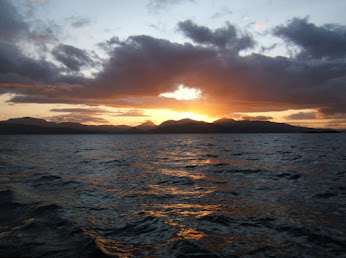On one of our most exciting sailing days yet, Cirrus has completed a circumnavigation of the island of Mull, all 87,794 hectares of it, all in one hit. I just had to state this as I'm not yet sure I believe it myself.
Our route took us past the heavily indented west coast of Mull and thus past the island of Staffa, one of the more curious natural phenomena on this earth. Fingal's Cave, well known largely thanks to Felix Mendelssohn's visit back in 1829, is but one feature on this rugged rocky outcrop, but the whole island shares a similar geology. For me, just as startling as the straight lines of the basalt columns which appear to support the island (Nature doesn't often do straight lines on this scale) is the amorphous volcanic topping which sits above this like cake icing, glued so firmly in place that centuries of pounding from the Atlantic haven't dislodged it. Even today, with all we now know about the strangeness of the world we live in, it is difficult to believe that this formation has occurred naturally, so what early man might have thought when they first passed this way is even harder to fathom. Would they have treated the place with reverence or with fear. For me the experience of sailing there and having Staffa to ourselves for just a short while was an incredible one.
The southern coast of Mull, the Ross, is a long, west-pointing finger of land tipped with a sprinkling of islands, Iona being the most well known. The Ross has some of the highest summits on Mull so to pass along this coast means sailing close to mountains sliced off by the sea, the land dropping vertically over 300 metres to sea level then carrying on again for another 100 metres or so below the sea.
The vast scale of all this rock is difficult to get to grips with and photos cannot really give much of an impression. Similarly, the phenomenon we were soon to experience here, wind, did not lend itself to photographs either as it is, after all, invisible. As we sailed into the lea of the first of these mighty monoliths there was a sudden lull, then ahead of us we could see streaks of mist over the water starting right at the base of the cliff and extending out across our path. This was something we had read about in books but had never before experienced. This was katabatic wind.
The vast scale of all this rock is difficult to get to grips with and photos cannot really give much of an impression. Similarly, the phenomenon we were soon to experience here, wind, did not lend itself to photographs either as it is, after all, invisible. As we sailed into the lea of the first of these mighty monoliths there was a sudden lull, then ahead of us we could see streaks of mist over the water starting right at the base of the cliff and extending out across our path. This was something we had read about in books but had never before experienced. This was katabatic wind.
In simple terms, what happens is that warm air at high level, as on the mountain top heated by the sun, starts to cool down and becomes heavier, more dense. Where it can, and in this case helped by the offshore breeze, the dense air begins to fall down towards the sea 300 metres below. By the time the air has reached sea level it is moving fast, as you might expect from anything falling this distance unimpeded. It hits the surface of the sea and immediately tears this into spray which is picked up and thrown at anything close to the cliff or even some distance away.
We immediately took all sail down and motored past as best we could as the impossible seemed to be happening; we were right beneath the cliff yet the 42 knot wind appeared to be coming directly out of the rock itself. It is no consolation to me that the cliff here is known as Malcolm's Point.
Tonight, by contrast, we are moored in Oban Bay where the waves from a light north-westerly wind keep Cirrus gently dancing about. Kate is weighing ingredients for some exotic pie she is cooking but the scales are being affected by the little bouncy movements of the boat and she can't get an accurate measurement. Gravity is misbehaving.
Still, the sunsets over Mull are good.



Although I have been following your blog since April, I have only just got organised enough to do the follower bit. Great views of Staffa!
ReplyDeleteVisiting Skye at the start of August so your blog is my reading material in preparation!
Great to have you on board, Graham.
ReplyDeleteWe are unlikely to visit Skye this year as there is *so* much else to see here. Hope you have a great time there.